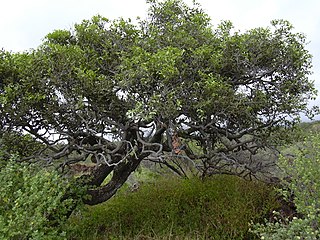
The Ebenaceae are a family of flowering plants belonging to order Ericales. The family includes ebony and persimmon among about 768 species of trees and shrubs. It is distributed across the tropical and warmer temperate regions of the world. It is most diverse in the rainforests of Malesia, India, tropical Africa and tropical America.
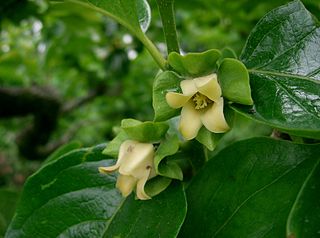
Diospyros is a genus of over 700 species of deciduous and evergreen trees and shrubs. The majority are native to the tropics, with only a few species extending into temperate regions. Individual species valued for their hard, heavy, dark timber, are commonly known as ebony trees, while others are valued for their fruit and known as persimmon trees. Some are useful as ornamentals and many are of local ecological importance. Species of this genus are generally dioecious, with separate male and female plants.

Mesua ferrea, the Ceylon ironwood, or cobra saffron, is a species in the family Calophyllaceae native to the Indomalayan realm. This slow-growing tree is named after the heaviness and hardness of its timber. It is widely cultivated as an ornamental for its graceful shape, grayish-green foliage with a beautiful pink to red flush of drooping young leaves, and large, fragrant white flowers. It is the national tree of Sri Lanka, as well as the state tree of Mizoram and state flower of Tripura in India.

Diospyros melanoxylon, the Coromandel ebony or East Indian ebony, is a species of flowering tree in the family Ebenaceae native to India and Sri Lanka; it has a hard, dry bark. Its common name derives from Coromandel, the coast of southeastern India. Locally it is known as temburini or by its Hindi name tendu. In Odisha, Jharkhand, and Assam, it is known as kendu. In Andhra Pradesh, and Telangana it is known as tuniki. The leaves can be wrapped around tobacco to create the Indian beedi, which has outsold conventional cigarettes in India. The olive-green fruit of the tree is edible.
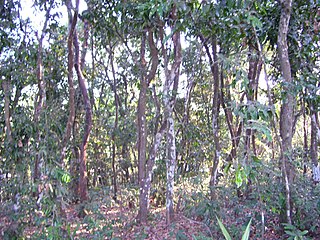
Diospyros ebenum, or Ceylon ebony , is a species of tree in the genus Diospyros and the family Ebenaceae. The tree produces valuable black wood.
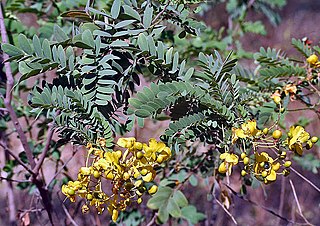
Senna auriculata is a leguminous tree in the subfamily Caesalpinioideae. It is commonly known by its local names matura tea tree, avaram or ranawara, or the English version avaram senna. It is the State flower of Indian state of Telangana. It occurs in the dry regions of India and Sri Lanka. It is common along the sea coast and the dry zone in Sri Lanka.

Ailanthus triphysa is a medium to tall evergreen rainforest tree in Asia and Australia. The wood may be used for matchwood and plywood. The tree is known as halmaddi in India, where its resin, also called halmaddi, may be used in incense. Inappropriate extraction methods were resulting in trees dying, so by the 1990s the Indian forestry department had banned extraction.

Nymphaea nouchali, often known by its synonym Nymphaea stellata, or by common names blue lotus, star lotus, red water lily, dwarf aquarium lily, blue water lily, blue star water lily or manel flower, is a water lily of genus Nymphaea. It is native to southern and eastern parts of Asia, and is the national flower of Bangladesh and Sri Lanka. In Sanskrit it is called utpala. This species is usually considered to include the blue Egyptian lotus N. nouchali var. caerulea. In the past, taxonomic confusion has occurred, with the name Nymphaea nouchali incorrectly applied to Nymphaea pubescens.

Ritigala is a mountain in central Sri Lanka which is home to an ancient Buddhist monastery. The ruins and rock inscriptions of the monastery date back to 1st century BCE. It is located 43 km (27 mi) away from the ancient monastic city of Anuradhapura.
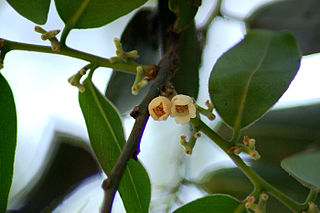
Diospyros malabarica, the gaub tree, Malabar ebony, black-and-white ebony or pale moon ebony, is a species of flowering tree in the family Ebenaceae that is native to the Indian Subcontinent and South East Asia.

Diospyros atrata is a tree in the family Ebenaceae. It commonly grows to 25 metres tall. The plant can be seen in subcanopy trees in medium elevation wet evergreen forests between 1000 and 1400 m in Western Ghats- South Sahyadri, Kerala, and Tamil Nadu in India and from Kandy district in Sri Lanka
Diospyros chaetocarpa, is a tree in the ebony family, native to south western parts of Sri Lanka, where it is known as "Kalu Madiriya" in the Sinhala language. The Sinhala name "Kalu Madiriya" is also known to be used for Diospyros oppositifolia.

Diospyros candolleana, is a tree in the Ebony family, endemic to the Western Ghats of India and Sri Lanka. The trees are usually 20m tall, and found as subcanopy trees in wet evergreen forests up to 90m.
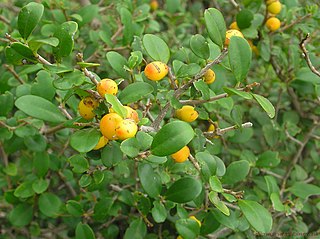
Diospyros ferrea, known as black ebony, is a tree in the ebony family, distributed in Burma (Myanmar), Cambodia, India, Indonesia, Malay Peninsula, Philippines, Sri Lanka, Thailand, Laos (Khammouan) and Taiwan.

Diospyros oocarpa, is a tree in the family Ebenaceae, native to Central and North Malanad of Central Sahyadri of Western Ghats and Sri Lanka. Sometimes, it is classified as a synonym of Diospyros marmorata.

Diospyros maritima is a tree in the family Ebenaceae. The specific epithet maritima means "by the sea", referring to the tree's habitat.
Diospyros venosa is a tree in the family Ebenaceae. It is native to Southeast Asia, from the Maluku Islands to Myanmar. It provides raw material for handicrafts, traditional medicine and fuel.
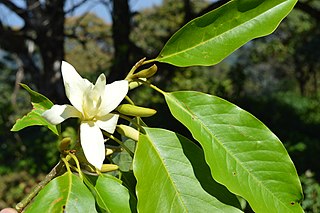
Magnolia nilagirica is a species of plant in the family Magnoliaceae. It is a tree that is threatened by habitat loss, endemic to the Western Ghats of India, and also Sri Lanka.
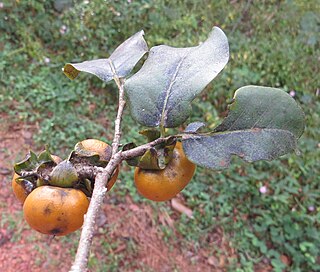
Diospyros montana, the Bombay ebony, is a small deciduous tree in the ebony family up to 15 metres (49 ft) tall, distributed all along the Western Ghats of India, Sri Lanka, Indo-China through to Australia.

Diospyros paniculata, or the panicle-flowered ebony, is a species of tree in the ebony family. Endemic to the Western Ghats area of India and parts of Bangladesh, the species is currently listed as Vulnerable in the IUCN Red List.

















